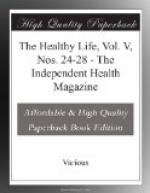And so also is it with regard to diet. The person who talks learnedly about germs and calories (though he never saw a germ or measured a calorie in his life) will be found in the same camp with the electric light advocate, while this other who cultivates a taste in harmony with Nature by consuming what he likes best of her unaltered products, he is found arm in arm with the sun-bather. But Science will by no means allow him to eat his uncooked food in peace. “If we all adopt that diet,” her pseudo-disciples cry, “what is to become of the potatoes?”
Now, with regard to uncooked foods, it would seem that as little fault can be found with ripe fruit in its natural state as with any article of diet. Yet even here “Science” holds up a warning hand and is succeeding in scaring people away from one of the most harmless, most wholesome and most neglected of foods.
Leaving generalities, let us come to a specific case, an actual difficulty propounded to me by a sufferer, one who had spent her substance till she could spend no more in having various parts of herself examined and in learned prescriptions and processes of cure, but who found herself as far from health as ever. Obsessed by certain theories of “Science,” this lady had acquired a dread of sugar in every form. Hence her query addressed to me: “In your book, No Rheumatism, you say that sugar is to be avoided. Why, then, do you recommend fruit, which is mostly sugar?”
I replied as follows: “The reason I recommend ripe uncooked fruit—in spite of its containing a certain quantity of sugar—is that it contains also purifying salts, and that for most people it is the pleasantest form in which these salts can be taken. Moreover, fruit sugar appears to be more wholesome than that formed from starch. When you say that ‘fruit is mostly sugar,’ are you not leaving the water of the fruit out of account? As the water often amounts to 90 per cent. this makes all the difference. Taking the fruits generally grown in this country the average proportion of sugar is seven per cent.
[This statement is based on the following figures
given in Goodale’s
Physiological Botany:—
Apples contain 7.73 per cent. sugar Pears " 8.26 " " Plums " 3.56 " " Strawberries 6.28 " " Gooseberries 7.03 " "
Grapes are stated to contain 24.36 per cent,
but often contain much
less and sometimes even more.]
“Now a person eating fruit ad lib., but allowed other foods, will hardly ever eat more than a pound or two a day (generally less). But suppose him to eat two pounds. Seven per cent. of this is 21/4 oz. If he eats only 1 lb. he takes 1+1/8 oz. sugar. Now compare this with the amount he gets from starchy foods, say, bread, which contains fifty per cent. of starch and




